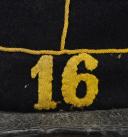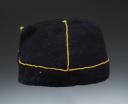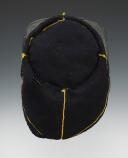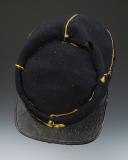
KÉPI DTROUP OF THE 16th BATTALION OF HUNTERS ON FOOT from Toulouse, Second Empire, circa 1860-1870. 27483
Sold out
KÉPI TROUP OF THE 16th BATTALION OF HUNTERS ON FOOT from Toulouse, Second Empire, circa 1860-1870. 27483
Kepi identical in shape to the infantry models, but in dark blue cloth with piping and corps number in cut-out daffodil cloth. Rigid square-shaped visor in black patent leather, lined with a green waxed morocco sheepskin on the underside, with exterior border trimmed with a folded leather rush sewn astride the exterior border. Inner cap entirely in black waxed sheepskin.
France.
Second Empire.
Good state of conservation, accident and damage to the cord, hole at the top of the cap in the rear part near the crown (2 cm x 1.5 cm), interior cap in good worn condition.
HISTORY:
The 16th Battalion of foot hunters was formed in Grenoble on January 15, 1854 and its command entrusted to Battalion Chief Esmieux.
From October 16, 1855 to July 5, 1856, he participated in the Crimean campaign, infamous for the deplorable sanitary conditions which were the daily lot of the expeditionary force. Charles Ardant du Picq, 2nd corps commander, describes these sad conditions in his book “Studies on combat”.
Returning to France, the battalion took up residence in Toulouse where it remained until 1860.
On August 5, 1860, embarked from Marseille for Beirut to participate in the Syrian expedition mounted by France with other European nations. This expedition, which today would be described as humanitarian, essentially aims to calm the spirits after the massacres of Christians perpetrated by the Druze in Mount Lebanon.
The battalion's mission consisted, in particular, of protecting the excavations around Djebail then Saïda in Syria, they earned the nickname "16th battalion of pickers".
Returning from Syria, he returned to his cantonments in Toulouse, then began a long journey which took him to Vincennes (1861), Paris (1863), Strasbourg (1866) and finally Besançon (1870), from where he left for the war from 1870.
On July 19, 1870, the battalion belonged to the 2nd Infantry Division of the 1st Army Corps of the Army of the Rhine. Immediately engaged on the German border, he distinguished himself in particular at Wissembourg then Niederbronn-les-Bains, a few kilometers from his current garrison, during the battle of Froeschwiller-Woerth.
After a withdrawal to Châlons, the 2nd Army Corps headed towards the Ardennes border where the terrible Battle of Sedan took place which led to the capitulation of Napoleon III. Part of the battalion will be besieged in Bitche.
Like the rest of the army defeated at Sedan, the 16th then went into captivity in Germany.
In Paris, as soon as the capitulation was announced, revolts broke out, the empire fell and the republic was proclaimed. The new authorities tried to continue the fight as best they could. Thus the depot of the 16th in Besançon received the order to set up four provisional companies which would constitute the 16th marching.
This new battalion joined the Army of the Loire and fought admirably at Orléans, then Beaugency and finally near Le Mans.
However, on January 29, 1871, the armistice was signed, the war ended in a crushing defeat: loss of Alsace and part of Lorraine, war indemnity of five billion gold francs, total diplomatic isolation.
The imperial army, poorly trained, poorly equipped but also poorly commanded, barely lasted more than three weeks and that of the Republic, a few months.
In April 1871, the executives and hunters of the old battalion returned from captivity: like their brothers in arms from the old Army of the Rhine, they were immediately hired by the very young 3rd Republic to put an end to the movements revolutionaries that broke out in the big cities. The 16th participated in the repression of the unrest in Guillotière (district of Lyon located on the left bank of the Rhône) until June.
During the summer of 1871, the various detachments of the 16th (marching battalion, prisoners returned from captivity and depot companies) were regrouped at the Sathonay camp and merged to form a new 16th BCP. The amalgam ended on September 15, when the battalion received orders to garrison Lyon.
During the post-war years, in a general atmosphere imbued with patriotism and militarism, "The spirit of revenge", the battalion will then experience an intense period of formation and training. He will also regularly change garrison and move closer to "the blue line of the Vosges" dear to Jules Ferry: Clermont-Ferrand (1876-1876), Embrun in the Hautes-Alpes (1876-1877), Lille and finally Labry (Meurthe and Moselle), (1913).
During the First World War, the 16thBCP, like the other hunter battalions and its infantry brothers-in-arms, was involved in all the battles of this gigantic confrontation which would bleed France and mark the country in an indelible manner.
Kepi identical in shape to the infantry models, but in dark blue cloth with piping and corps number in cut-out daffodil cloth. Rigid square-shaped visor in black patent leather, lined with a green waxed morocco sheepskin on the underside, with exterior border trimmed with a folded leather rush sewn astride the exterior border. Inner cap entirely in black waxed sheepskin.
France.
Second Empire.
Good state of conservation, accident and damage to the cord, hole at the top of the cap in the rear part near the crown (2 cm x 1.5 cm), interior cap in good worn condition.
HISTORY:
The 16th Battalion of foot hunters was formed in Grenoble on January 15, 1854 and its command entrusted to Battalion Chief Esmieux.
From October 16, 1855 to July 5, 1856, he participated in the Crimean campaign, infamous for the deplorable sanitary conditions which were the daily lot of the expeditionary force. Charles Ardant du Picq, 2nd corps commander, describes these sad conditions in his book “Studies on combat”.
Returning to France, the battalion took up residence in Toulouse where it remained until 1860.
On August 5, 1860, embarked from Marseille for Beirut to participate in the Syrian expedition mounted by France with other European nations. This expedition, which today would be described as humanitarian, essentially aims to calm the spirits after the massacres of Christians perpetrated by the Druze in Mount Lebanon.
The battalion's mission consisted, in particular, of protecting the excavations around Djebail then Saïda in Syria, they earned the nickname "16th battalion of pickers".
Returning from Syria, he returned to his cantonments in Toulouse, then began a long journey which took him to Vincennes (1861), Paris (1863), Strasbourg (1866) and finally Besançon (1870), from where he left for the war from 1870.
On July 19, 1870, the battalion belonged to the 2nd Infantry Division of the 1st Army Corps of the Army of the Rhine. Immediately engaged on the German border, he distinguished himself in particular at Wissembourg then Niederbronn-les-Bains, a few kilometers from his current garrison, during the battle of Froeschwiller-Woerth.
After a withdrawal to Châlons, the 2nd Army Corps headed towards the Ardennes border where the terrible Battle of Sedan took place which led to the capitulation of Napoleon III. Part of the battalion will be besieged in Bitche.
Like the rest of the army defeated at Sedan, the 16th then went into captivity in Germany.
In Paris, as soon as the capitulation was announced, revolts broke out, the empire fell and the republic was proclaimed. The new authorities tried to continue the fight as best they could. Thus the depot of the 16th in Besançon received the order to set up four provisional companies which would constitute the 16th marching.
This new battalion joined the Army of the Loire and fought admirably at Orléans, then Beaugency and finally near Le Mans.
However, on January 29, 1871, the armistice was signed, the war ended in a crushing defeat: loss of Alsace and part of Lorraine, war indemnity of five billion gold francs, total diplomatic isolation.
The imperial army, poorly trained, poorly equipped but also poorly commanded, barely lasted more than three weeks and that of the Republic, a few months.
In April 1871, the executives and hunters of the old battalion returned from captivity: like their brothers in arms from the old Army of the Rhine, they were immediately hired by the very young 3rd Republic to put an end to the movements revolutionaries that broke out in the big cities. The 16th participated in the repression of the unrest in Guillotière (district of Lyon located on the left bank of the Rhône) until June.
During the summer of 1871, the various detachments of the 16th (marching battalion, prisoners returned from captivity and depot companies) were regrouped at the Sathonay camp and merged to form a new 16th BCP. The amalgam ended on September 15, when the battalion received orders to garrison Lyon.
During the post-war years, in a general atmosphere imbued with patriotism and militarism, "The spirit of revenge", the battalion will then experience an intense period of formation and training. He will also regularly change garrison and move closer to "the blue line of the Vosges" dear to Jules Ferry: Clermont-Ferrand (1876-1876), Embrun in the Hautes-Alpes (1876-1877), Lille and finally Labry (Meurthe and Moselle), (1913).
During the First World War, the 16thBCP, like the other hunter battalions and its infantry brothers-in-arms, was involved in all the battles of this gigantic confrontation which would bleed France and mark the country in an indelible manner.
Reference :
27483
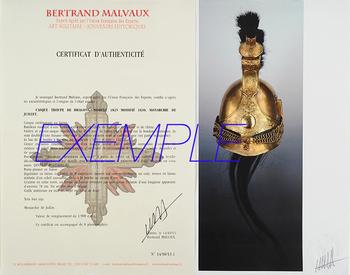
Next update Friday, november 14 at 13:30 PM
FOR ALL PURCHASES, PAYMENT IN MULTIPLE CHECKS POSSIBLE
bertrand.malvaux@wanadoo.fr 06 07 75 74 63
SHIPPING COSTS
Shipping costs are calculated only once per order for one or more items, all shipments are sent via registered mail, as this is the only way to have proof of dispatch and receipt.
For parcels whose value cannot be insured by the Post, shipments are entrusted to DHL or Fedex with real value insured, the service is of high quality but the cost is higher.
RETURN POLICY
Items can be returned within 8 days of receipt. They must be returned by registered mail at the sender's expense, in their original packaging, and in their original condition.
AUTHENTICITY
The selection of items offered on this site allows me to guarantee the authenticity of each piece described here, all items offered are guaranteed to be period and authentic, unless otherwise noted or restricted in the description.
An authenticity certificate of the item including the description published on the site, the period, the sale price, accompanied by one or more color photographs is automatically provided for any item priced over 130 euros. Below this price, each certificate is charged 5 euros.
Only items sold by me are subject to an authenticity certificate, I do not provide any expert reports for items sold by third parties (colleagues or collectors).
FOR ALL PURCHASES, PAYMENT IN MULTIPLE CHECKS POSSIBLE
bertrand.malvaux@wanadoo.fr 06 07 75 74 63
An authenticity certificate of the item including the description published on the site, the period, the sale price, accompanied by one or more color photographs is automatically provided for any item priced over 130 euros. Below this price, each certificate is charged 5 euros.
Only items sold by me are subject to an authenticity certificate, I do not provide any expert reports for items sold by third parties (colleagues or collectors).

